She feels really easy and comfortable to sail, even in a good breeze and a chop.
- Traditional look and feel
- Family- and pet-friendly layout
- Volvo Penta power with Slow Mode
- Full displacement hull
- Economical cruising
Marvic is one of the most recent additions to Taupo’s pleasure boat fleet. She’s certainly one of the larger vessels that call the new marina at Motuapa home and she’s turning quite a few heads around the Great Lake.
An Integrity 380 Sedan, Marvic is the first of this latest version in New Zealand. Integrity Motor Yachts is an Australian company, now part of the Whitehaven Group, that builds traditional trawler-style yachts in China and a range of luxury powerboats in Taiwan and Taipei. I reviewed an earlier version of this model a few years ago (Boating NZ, September 2013).
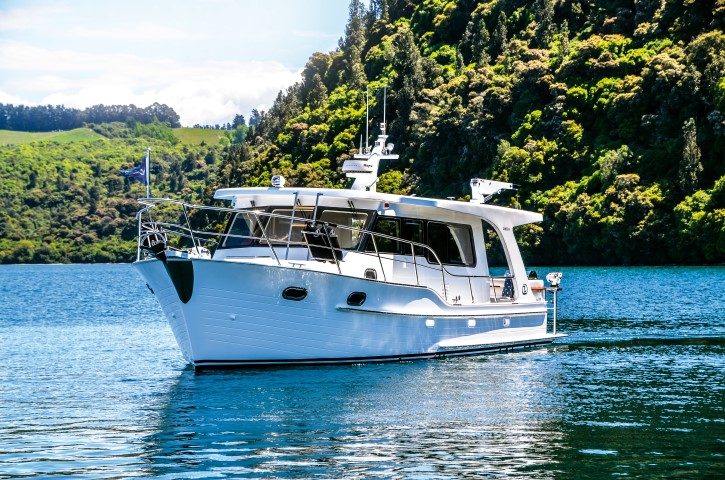
The Chinese manufacturer, Jianghua Marine, has been building yachts for many years, and Integrity yachts for eight years. Essentially, the 380 Sedan is a development of the popular Integrity 340 Sedan, extended and updated. The 380 is available in flybridge or sedan versions.
Marvic is a sedan-style launch with a full-beam cabin top that covers the cockpit and walkaround side decks. Wrap-around bulwarks (with scuppers) and railings are family- and pet-friendly.
The 380’s a displacement vessel with a full-length keel that protects the propeller and rudder. A 225hp John Deere is the standard powerplant, but John, Marvic’s owner, specified a Volvo Penta 330hp for his boat. The Volvo offers electronic throttle and shift and Slow Mode, which allows the vessel to trickle along at three knots – very important when you are as keen on trolling for trout as is John.

The development of the new marina was the new boat catalyst for John.
“I’d never have got her in and out of the old marina, but once the new one opened, I decided it was a good time to upgrade to a larger vessel,” says John, replacing an 8m launch he’d kept at Motuoapa for many years.
The Volvo’s extra horses make no difference to the Integrity’s top speed, which is around 11 knots, but the engine is nicely under-stressed when cruising at 8 knots. And cruising is what the 380 is all about – in considerable comfort.
One-level living blends inside and outside thanks to a combination of two large hopper windows and a sliding half-height stable door opening the saloon to the cockpit and the water beyond. The helmsman’s side door and deep, sliding side windows in the saloon further open the boat to the outside, letting in light and air. The vessel also has reverse-cycle air-conditioning, which John and his extended family will appreciate on those chilly winter mornings out on the lake.
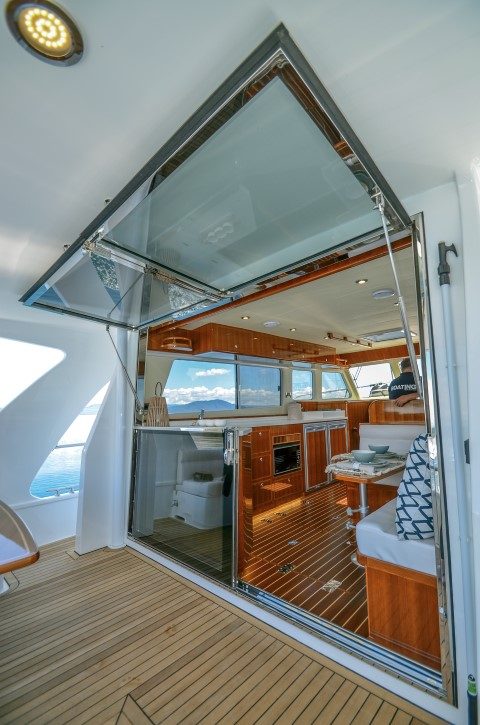
With fishing on his mind, John opted for an extended 1.2m wide swim platform with stainless steel rails for security when playing a trout and as somewhere to mount the stainless-steel BBQ and a pair of top-of-the-range Cannon electric downriggers, one on each corner.
The Cannons interface with a transducer to lift and lower the downrigger weights in sync with lake floor contour changes, ensuring the lures are always at the optimum depth in relation to the lake bed. The railing also supports a good-sized bait station/filleting board with rod holders.
While trickling along in Slow Mode waiting for a fish to bite, you can enjoy the lake scenery from the comfort and shelter of the cockpit. In winter, cockpit covers fully enclose the space, turning it into a cosy extension of the saloon, but on a brilliant spring day like we enjoyed, the fresh air and sunshine was welcome and we left the covers off.
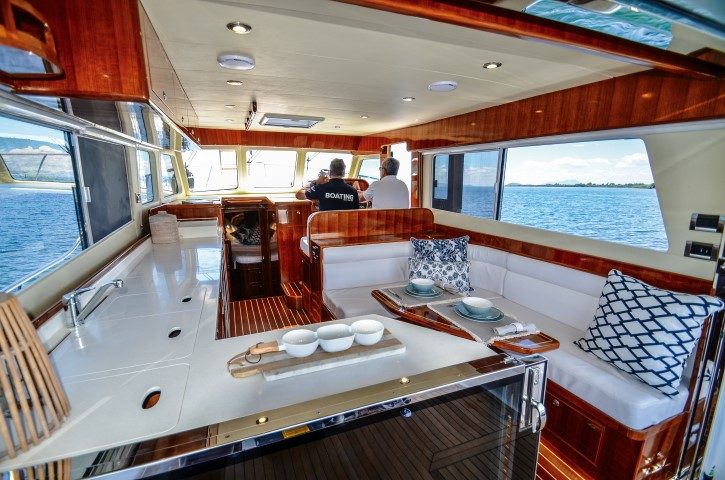
As an extension of the saloon and an extra dining/entertaining area, the cockpit works brilliantly. Seating wraps right around the transom and the polished teak table drops down to form a large double berth when the squabs are added. By all accounts it’s a pleasant place to sleep with cockpit covers fitted.
The best part is the easy flow between the cockpit and the saloon. The galley is aft on the port side, the return on its L-shaped Corian work surface functioning as a natural buffet servery for guests in the cockpit.
Aft galleys seem to resonate with Kiwi boaters and this one is larger than most, the bench extending all the way down the port side of the cabin. It provides a huge food prep area with under-bench fridge and freezer units and inverter/microwave oven. Electric hobs (three – two is standard) are hidden under the bench top, as is the double sink.
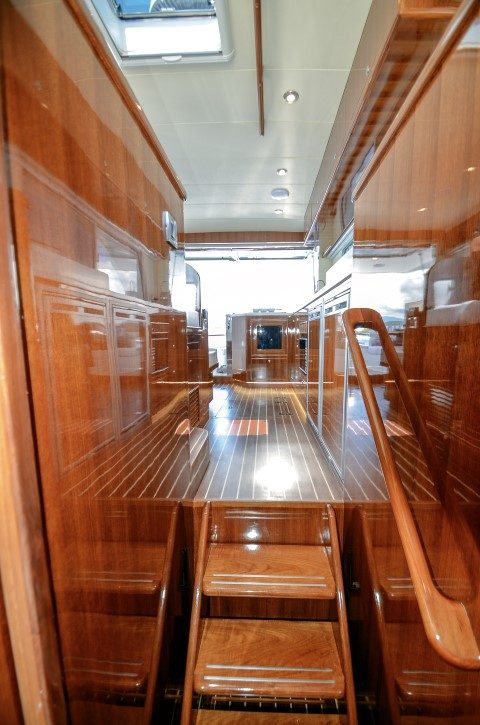
There is a very traditional look and feel to the boat’s interior, accentuated by lavish use of high-gloss teak trim, including the helm console fascia, and the teak and holly soles. It works very well in this vessel, which still manages to feel open and light, thanks to big windows and a lovely flow out to the cockpit and beyond. It doesn’t hurt, either, that living areas, inside and out, are on one level.
The polished teak saloon table easily accommodates two or three at meal times or more when socialising. For entertainment, a flat-screen TV is raised and lowered electrically from behind the helm seat and there’s a Fusion stereo system.
In this version of the 380, sleeping accommodation is in two cabins. The guest cabin is to starboard with a good-sized double berth and plenty of stowage, but with the foot of the bed extending under the saloon sole it’s a reasonably tight fit.
The master cabin in the bow is more spacious, with an island berth, decent hanging lockers and extra shelving with custom, turned teak railings. Both cabins exude traditional charm, continuing the polished wood theme of the saloon, while skylights and portholes let in plenty of light.
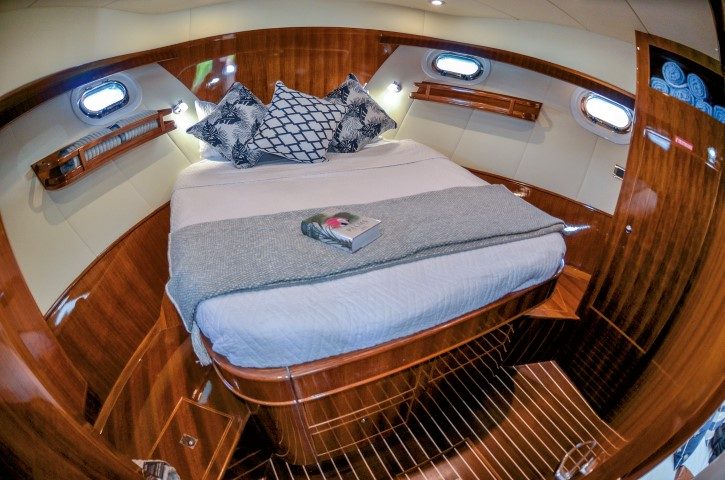
The roomy bathroom is shared and features a separate shower cabinet.
The Integrity 380 looks to be a solidly-built boat, as her 11-tonne displacement confirms. Even the well-insulated engine room hatches in the saloon sole are solid, but assisted by gas struts, they’re easy enough to raise. The white-painted engine room has good access, as do all the engine’s service points and ancillary equipment.
An Onan 7kVA generator, Victron inverter and twin battery banks find ample space inside the engine room. I was struck by how massive the engine bearers are, which again reflects the vessel’s solid build.
As we exited the marina, the super-clear waters of Stump Bay revealed shallow, weed-covered banks either side of the marked channel. In a boat of this size, some care is required to stay in the channel. But helming Marvic is stress-free. Lewmar stern and bow thrusters work with Volvo Penta’s Slow Mode to take any anxiety out of handling the boat at close quarters. Marvic fits a 12m berth – just – but berthing her was easy and the helmsman’s side door is handy dockside.
Out on the lake, we made stately progress towards the bays and cliffs of Taupo’s southern end, travelling at a steady eight knots in gorgeous conditions. The only helm station is inside the cabin, but with all the windows and doors open, sun and air streamed in. It was all very pleasant.
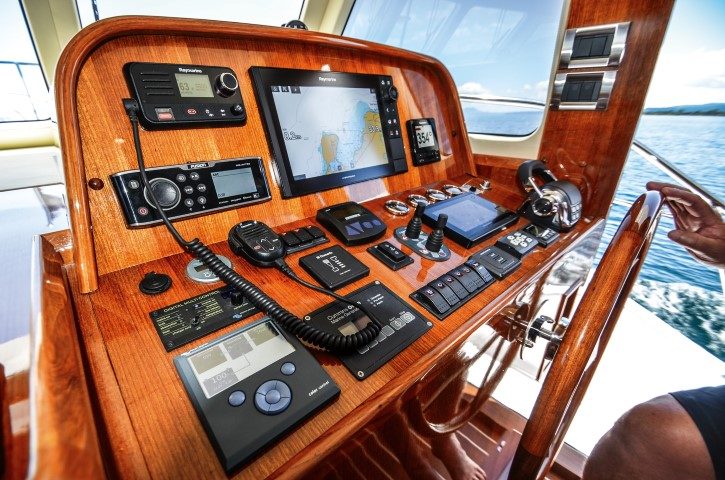
At eight knots the fuel burn is very reasonable 24lph; push the speed up to 11 knots and it ramps up, along with the noise levels, though the 380 is a quiet runner. On the other hand, at trolling speed there’s barely any noise from the exhaust and fuel consumption is miserly.
The bench-style helm seat comfortably accommodates two side by side. Fold-out teak footrests and a massive wooden wheel afford a comfortable helming position behind the wide console. It feels very ship-like with three large windows, each with its own wiper, and solid mullions between them.
There’s ample room on the two-tier dash for instruments, electronics and communications equipment. Marvic is quite well-specced. A Raymarine MFD occupies centre-stage with a standard Volvo Penta digital display, thruster, Marinco spotlight, Muir capstan, chain counter, genset and various other controls, sharing space with analogue gauges, switches, the VHF radio, Fusion stereo, 12V and USB outlets, tank level indicator and the Raymarine autopilot.

One of the advantages of the Volvo set-up is that, unlike the standard John Deere, it’s an electronic engine with electronic throttle and shift with no stretchy cables to adjust.
Most owners carry a tender on the swim platform, but John wanted to keep that area clear for fishing, so Marvic has a Davco electric davit and a cradle on the roof just aft of the radar mast for the RIB. Access to the roof is via a ladder from the foredeck – it’s a massive space and the roof is strong too, since it supports the flybridge superstructure in flybridge models.
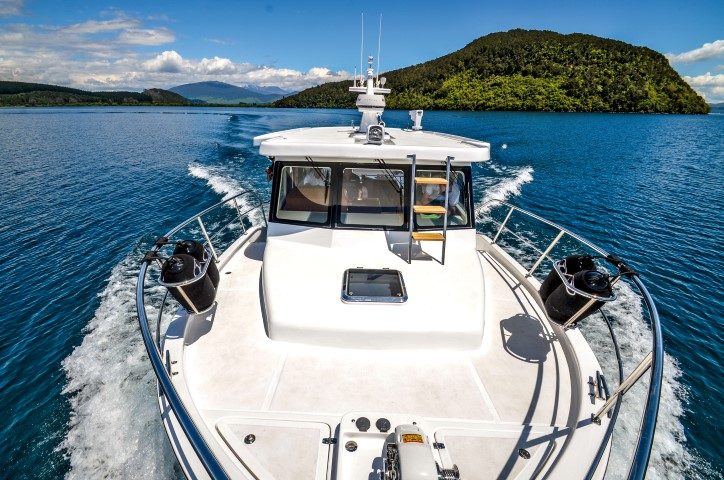
Marvic looks quite at home on Lake Taupo. Resplendent in bright-white gel-coat, with a jaunty pennant flying from the bow rail, she’ll be hard to miss. With his new boat, John intends to explore more of the lake at his leisure, occasionally overnighting with family and friends as the fancy takes him. That’s in addition to his usual fishing excursions.
The Integrity 380 is perfect for relaxed cruising where the journey (or the fishing) is as important as the destination.
She feels really easy and comfortable to sail, even in a good breeze and a chop.
At first glance the boat appears to be a large centre console, although hidden beneath the console and forward area is a sizeable overnight cabin.
With classic styling, good performance and class-leading ride and handling, there’s a lot to like about the Caribbean 32.
Solar panels on the vast roof help keep the batteries charged.